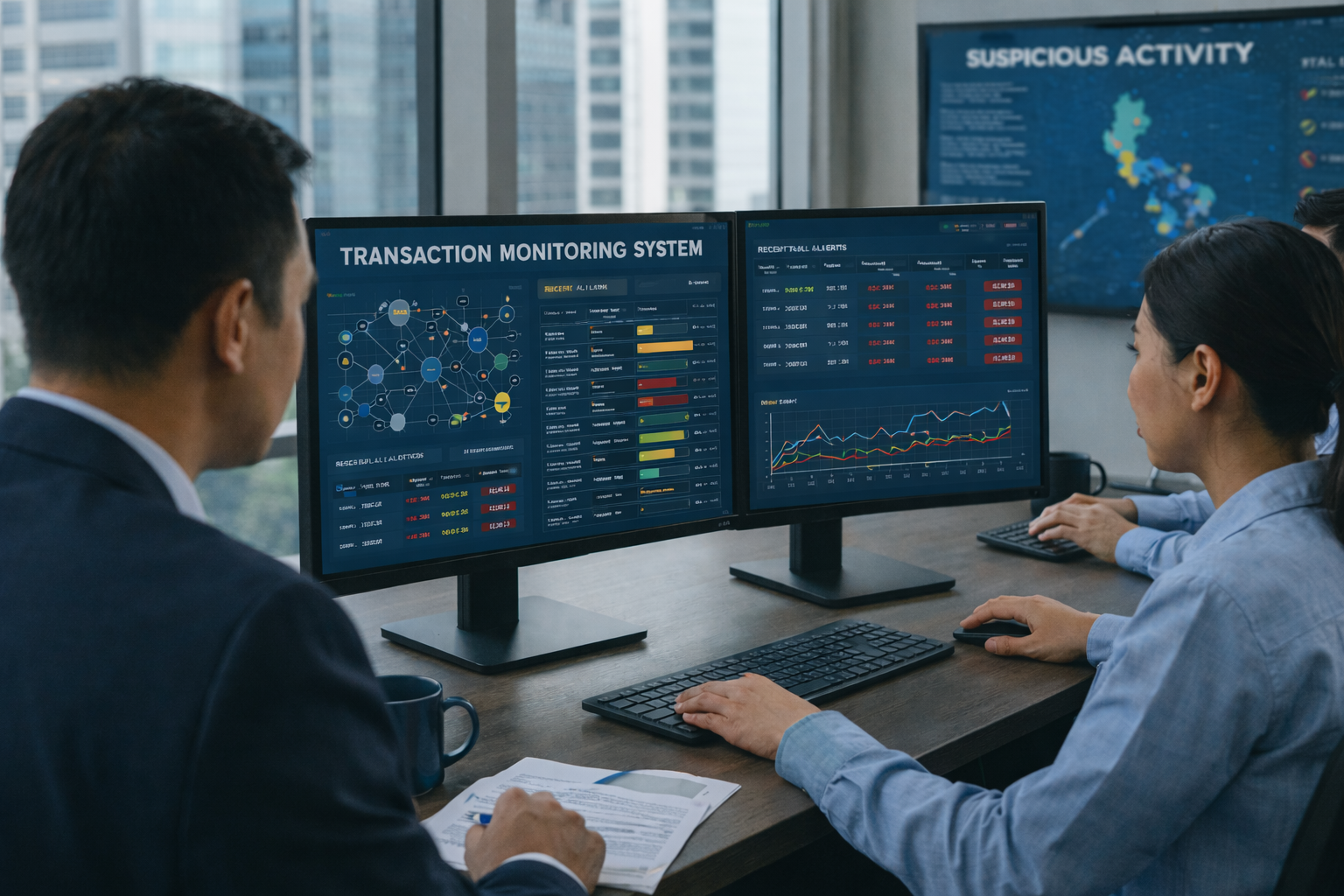AMLC Registration and Reporting Guidelines: An Overview
.svg)
The Anti-Money Laundering Council (AMLC) plays a crucial role in the Philippines' fight against money laundering and terrorism financing. The 2021 AMLC Registration and Reporting Guidelines provide a structured framework for financial institutions and covered persons to comply with legal requirements. These guidelines are essential for ensuring complete, accurate, and timely reporting of transactions to detect and prevent financial crimes.
Legal Framework
The AMLC's guidelines are rooted in the Anti-Money Laundering Act of 2001, also known as Republic Act No. 9160. This act provides the primary legal foundation for reporting covered and suspicious transactions. According to the guidelines, "Section 7(1) of the AMLA authorizes the AMLC to require, receive and analyze covered and suspicious transaction reports from covered persons."
These guidelines are further supported by the 2018 Implementing Rules and Regulations (IRR). The IRR outlines the specific procedures and standards for reporting, ensuring that covered persons are clear on their obligations. This combination of laws and regulations forms a robust framework for AMLC’s operations.
{{cta-first}}
Key Definitions
Understanding the terminology used in the AMLC guidelines is crucial. A "covered person" includes financial institutions and designated non-financial businesses and professions (DNFBPs) required to report transactions. The guidelines define a covered transaction as "a transaction in cash or other equivalent monetary instrument exceeding Five Hundred Thousand pesos (PHP500,000.00)."
Suspicious transactions are those that raise red flags or do not align with the customer's known profile or activities. According to the guidelines, a suspicious transaction is one "where any of the suspicious circumstances... is determined, based on suspicion or, if available, reasonable grounds, to be existing." Familiarity with these definitions helps in complying with the AMLC's reporting requirements.
Reporting Requirements
The AMLC guidelines outline two main types of reports: Covered Transaction Reports (CTRs) and Suspicious Transaction Reports (STRs). CTRs must be reported for any cash transaction exceeding PHP500,000. The guidelines specify that these reports must be submitted "within five (5) working days from occurrence thereof."
STRs, on the other hand, involve transactions that appear unusual or suspicious based on various red flags. These transactions should be reported promptly, with the guidelines stating that STRs must be filed "within the next working day from the occurrence thereof." Understanding these reporting requirements ensures that financial institutions and covered persons meet their obligations under the law.
Online Registration System (ORS)
To streamline the reporting process, the AMLC requires all covered persons to register with its Online Registration System (ORS). This system enables Compliance Officers to manage their user accounts and submit reports electronically. The guidelines state, “All covered persons shall register with the AMLC’s electronic reporting system in accordance with the registration and reporting guidelines.”
The registration process involves several steps, including generating a public key using Gnu Privacy Guard (GPG) software. Compliance Officers must upload necessary documents, such as a Secretary Certificate or Board Resolution, to complete the AMLA registration. This ensures secure and efficient transmission of reports to the AMLC. Various AMLC reporting tools such as GPG for Windows, GPG for Mac OS and AMLC Public Key can be downloaded from the official website.
Transaction Security Protocol
The security of transaction reports is paramount. The AMLC mandates the use of the File Transfer and Reporting Facility (FTRF) with HTTPS for secure data transmission. This protocol "provides data encryption, server authentication and message integrity," ensuring that sensitive information is protected.
Covered persons must use Gnu Privacy Guard (GPG) software to encrypt and sign their reports. The guidelines specify that "the compliance officer of the CP shall generate his private key as well as public key using GPG." This process ensures that only authorized parties can access and verify the transaction data, maintaining the integrity and confidentiality of the reports.
Reporting Procedures
The AMLC guidelines detail the specific procedures for submitting Covered Transaction Reports (CTRs) and Suspicious Transaction Reports (STRs). These reports must include comprehensive data elements, such as transaction date, amount, and the involved parties' details. The guidelines provide detailed charts and formats to ensure consistency and accuracy in reporting.
For bulk reporting, the AMLC requires reports to be submitted in specific electronic record formats. This ensures that large volumes of data are transmitted securely and efficiently. According to the guidelines, "Reports shall be submitted in a secured manner to the AMLC in electronic form." Adhering to these procedures helps maintain the quality and reliability of the information provided.
Compliance Checking and Administrative Sanctions
To ensure adherence to the AMLC guidelines, the Compliance and Supervision Group (CSG) conducts both onsite and offsite inspections. These checks are vital for verifying that covered persons follow the reporting requirements accurately and timely. According to the guidelines, "Compliance findings may be the subject of the Enforcement Action Guidelines (EAG)," which allows for the imposition of enforcement actions if necessary.
High-risk violations can lead to administrative sanctions. The guidelines specify that "High-risk violations of the ARRG shall be subject to administrative sanctions," which may include fines or other penalties. These measures ensure that covered persons remain diligent in their compliance efforts, thus supporting the AMLC’s mission to combat money laundering and terrorism financing.
Annexes
The AMLC guidelines include several annexes that provide additional resources and examples to aid compliance.
Annex A - Sample CSV Files
Annex A offers sample CSV files, which serve as templates for preparing transaction reports. This helps covered persons ensure that their reports meet the required format and data elements, streamlining the reporting process and reducing errors.
Annex B - System Codes
Annex B lists the system codes used in the reporting process. These codes are crucial for standardizing reports and ensuring that all data is interpreted correctly by the AMLC’s systems.
Annex C - Mandatory Fields
Annex C specifies the mandatory fields for different types of reports. Adhering to these requirements ensures that all necessary information is included in the reports, enhancing their usefulness and accuracy.
Annex D - Examples of Red Flags and Alerts
Annex D lists examples of red flags and alerts, helping institutions identify suspicious transactions more effectively. The guidelines emphasize the importance of recognizing these indicators, stating, "Covered persons should have systems in place that would alert its responsible officers or employees of any circumstance or situation that would give rise to a suspicion of ML/TF activity or transaction." Examples include unusual transaction amounts, frequent transactions that do not align with a customer's profile, and transactions involving high-risk jurisdictions.
Annex E - Typologies
Annex E includes typologies of money laundering and terrorism financing cases. These real-world examples illustrate common methods used by criminals to launder money or finance terrorism. Understanding these typologies helps institutions develop better detection and prevention strategies. The guidelines note, "The presence of these typologies in transactions should prompt covered persons to perform enhanced due diligence."
{{cta-ebook}}
Final Thoughts
Complying with the AMLC Registration and Reporting Guidelines is vital for financial institutions and other covered persons in the Philippines. These guidelines provide a structured framework for identifying, reporting, and mitigating risks associated with money laundering and terrorism financing. By understanding the legal framework, key definitions, reporting requirements, and utilizing the provided tools and resources, institutions can ensure they meet their obligations under the law.
Accurate and timely reporting supports the AMLC’s efforts to combat financial crimes effectively. Adherence to these guidelines not only fulfills legal obligations but also enhances the integrity and stability of the financial system. Financial institutions must stay vigilant and proactive in their compliance efforts to contribute to a safer financial environment.
Navigating the complexities of AMLC compliance can be challenging, but Tookitaki's compliance solutions are here to help. Our advanced technology assists compliance professionals in the Philippines with the detection, investigation, and reporting of financial crimes. By leveraging Tookitaki’s cutting-edge tools, you can ensure accurate and timely compliance with AMLC guidelines, thereby enhancing your institution’s ability to combat money laundering and terrorism financing effectively.
Discover how Tookitaki can support your compliance needs and streamline your reporting processes. Learn more about Tookitaki's compliance solutions today!
Experience the most intelligent AML and fraud prevention platform
Experience the most intelligent AML and fraud prevention platform
Experience the most intelligent AML and fraud prevention platform
Top AML Scenarios in ASEAN

The Role of AML Software in Compliance

The Role of AML Software in Compliance










